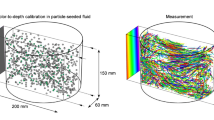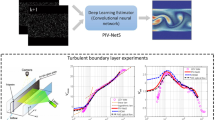Abstract
The algorithm of three-dimensional (3D) particle cloud reconstruction is a building block for 3D particle tracking velocimetry (3D-PTV). In the present study, a new 3D particle cloud reconstruction algorithm, i.e., neural-network-enhanced line of sight (NN-LOS), is proposed to update the traditional method based on Line of Sight (LOS) algorithm. The essence of NN-LOS is to use a matching neural network (Matching-NN) to evaluate whether or not one set of candidate matching being recorded by different cameras with various viewing perspectives is valid. Such a Matching-NN is in situ trained from virtual datasets that are synthetically generated by taking into account both the spatial calibration information and the actual seeding density in one particular experiment setup. This makes NN-LOS be self-adaptive to the measurement configuration, and thus avoids the problem of properly selecting a filtering threshold for the reprojection error in LOS. Both a series of synthetic tests and one surface morphology measurement are taken to prove that comparing to LOS, NN-LOS provides a significant improvement of the matching accuracy at high seeding density. A 3D-PTV measurement of a vortex ring in a synthetic jet is experimentally performed to demonstrate the advantage of NN-LOS. Comparing to tomographic particle image velocimetry, NNLOS-PTV enhances the spatial resolution of the velocity-field measurement and reduces the uncertainty of instantaneous velocity. The performance improvement is further empirically explained by a semiempirical test.


















Similar content being viewed by others
Data availability
Data underlying the results presented in this paper are not publicly available at this time but can be obtained from the authors upon reasonable request.
References
Atkinson C, Soria J (2009) An efficient simultaneous reconstruction technique for tomographic particle image velocimetry. Exp Fluids 47:553–568
Champagnat F, Cornic P, Cheminet A, Leclaire B, Le Besnerais G, Plyer A (2014) Tomographic PIV: particles versus blobs. Meas Sci Technol 25:084002. https://doi.org/10.1088/0957-0233/25/8/084002
Cheminet A, Krawczynski JF, Druault P (2018) Particle image reconstruction for particle detection in particle tracking velocimetry. Meas Sci Technol 29:125202. https://doi.org/10.1088/1361-6501/aae9c2
Cornic P, Leclaire B, Champagnat F, Le Besnerais G, Cheminet A, Illoul C, Losfeld G (2020) Double-frame tomographic PTV at high seeding densities. Exp Fluids 61:1–24. https://doi.org/10.1007/s00348-019-2859-2
Discetti S, Natale A, Astarita T (2013) Spatial filtering improved tomographic PIV. Exp Fluids 54:13
Dou JY, Pan C, Liu JH (2021) Robustness of neural network calibration model for accurate spatial positioning. Opt Express 29:32922–32938
Elsinga GE, Scarano F, Wieneke B, van Oudheusden BW (2006) Tomographic particle image velocimetry. Exp Fluids 41:933–947
Han Y, Pan C, Cheng Z, Xu Y (2023) A PTV-based feature-point matching algorithm for binocular stereo photogrammetry. Meas Sci Technol 34:125602. https://doi.org/10.1088/1361-6501/acf875
Jahn T, Schanz D, Schroder A (2021) Advanced iterative particle reconstruction for Lagrangian particle tracking. Exp Fluids 62:1–27. https://doi.org/10.1007/s00348-021-03276-7
Khojasteh AR, Yang Y, Heitz D, Laizet S (2021) Lagrangian coherent track initialization. Phys Fluids 33:095113. https://doi.org/10.1063/5.0060644
Nie MY, Pan C, Wang JJ, Cai CJ (2021) A hybrid 3d particle matching algorithm based on ant colony optimization. Exp Fluids 62:1–17. https://doi.org/10.1007/s00348-021-03160-4
Nie MY, Pan C, Xu Y, Wang JJ, Chen S, Shen JQ (2022) A framework of particle missing compensation for particle tracking velocimetry via global optimization. Exp Fluids 63:148. https://doi.org/10.1007/s00348-022-03478-7
Nishino K, Kasagi N, Hirata M (1989) Three-dimensional particle tracking velocimetry based on automated digital image processing. J Fluids Eng 111:384–391
Novara M, Batenburg KJ, Scarano F (2010) Motion tracking-enhanced mart for tomographic PIV. Meas Sci Technol 21:035401. https://doi.org/10.1088/0957-0233/21/3/035401
Schanz D, Gesemann S, Schroder A (2016) Shake-the-box: Lagrangian particle tracking at high particle image densities. Exp Fluids 57:1–27. https://doi.org/10.1007/s00348-016-2157-1
Schroder A, Schanz D (2023) 3d Lagrangian particle tracking in fluid mechanics. Annu Rev Fluid Mech 55:511–540
Schroder A, Willert C, Schanz D, Geisler R, Jahn T, Gallas Q, Leclaire B (2020) The flow around a surface mounted cube: a characterization by time-resolved PIV, 3D Shake-The-Box and LBM simulation. Exp Fluids 61:189. https://doi.org/10.1007/s00348-020-03014-5
Wang L, Feng L-H (2022) Dynamics of the interaction of synthetic jet vortex rings with a stratified interface. J Fluid Mech 943:A1. https://doi.org/10.1017/jfm.2022.379
Wang CY, Gao Q, Wang HP, Wei RJ, Li T, Wang JJ (2016) Divergence-free smoothing for volumetric PIV data. Exp Fluids 57:1–23. https://doi.org/10.1007/s00348-015-2097-1
Wang HP, Gao Q, Wei RJ, Wang JJ (2016) Intensity-enhanced mart for tomographic PIV. Exp Fluids 57:19
Wang L, Feng LH, Xu Y (2019) Laminar-to-transitional evolution of three-dimensional vortical structures in a low-aspect-ratio rectangular synthetic jet. Exp Thermal Fluid Sci 104:129–140
Wang Q, Zhu HJ, Zhao CY (2023) A parametric study of 3D PTV algorithms based on a two-view collimated imaging model. Meas Sci Technol 34:035302. https://doi.org/10.1088/1361-6501/acab1f
Westerweel J, Elsinga GE, Adrian RJ (2013) Particle image velocimetry for complex and turbulent flows. Annu Rev Fluid Mech 45:409–436
Wieneke B (2005) Stereo-PIV using self-calibration on particle images. Exp Fluids 39:267–280
Wieneke B (2008) Volume self-calibration for 3d particle image velocimetry. Exp Fluids 45:549–556
Wieneke B (2013) Iterative reconstruction of volumetric particle distribution. Meas Sci Technol 24:024008. https://doi.org/10.1088/0957-0233/24/2/024008
Wieneke B (2018) Improvements for volume self-calibration. Meas Sci Technol 29:084002. https://doi.org/10.1088/1361-6501/aacd45
Funding
This work was financially supported by the Foundation of State Key Laboratory of Aerodynamics (Grant No. SKLA-20200101), the National Natural Science Foundation of China (NSFC Grants Nos. 12225202, 91952302 and 61935008), and the National Key Research and Development Program (Grant No. 2020YFA0405700).
Author information
Authors and Affiliations
Corresponding author
Additional information
Publisher's Note
Springer Nature remains neutral with regard to jurisdictional claims in published maps and institutional affiliations.
Rights and permissions
Springer Nature or its licensor (e.g. a society or other partner) holds exclusive rights to this article under a publishing agreement with the author(s) or other rightsholder(s); author self-archiving of the accepted manuscript version of this article is solely governed by the terms of such publishing agreement and applicable law.
About this article
Cite this article
Dou, J., Pan, C., Han, Y. et al. Neural-network-enhanced line-of-sight method for 3D particle cloud reconstruction in particle tracking velocimetry. Exp Fluids 65, 59 (2024). https://doi.org/10.1007/s00348-024-03796-y
Received:
Revised:
Accepted:
Published:
DOI: https://doi.org/10.1007/s00348-024-03796-y




